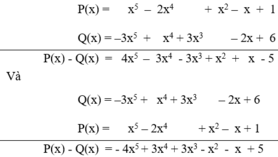
Hãy nhập câu hỏi của bạn vào đây, nếu là tài khoản VIP, bạn sẽ được ưu tiên trả lời.


a: \(M\left(x\right)=3x^5-2x^3+x^2-6\)
\(N\left(x\right)=-x^4+3x^3-4x^3-2x^2+\dfrac{1}{3}=-x^4-x^3-2x^2+\dfrac{1}{3}\)

a)bậc của da thức 2x-5xy+3x2 là:5
b)bậc của da thức ax2+2x2 là:4
c)bậc của da thức ax3+2xy là:5
d)bậc của da thức 4y2-3y4 là:6
e)bậc của da thức -3x5-\(\dfrac{1}{2}\)x3y-\(\dfrac{3}{4}\)xy2+3x5+2 là:17

Sắp xếp lại các hạng tử của Q(x) ta có :
Q(x) = –3x5 + x4 + 3x3 – 2x + 6.
Đặt và thực hiện các phép tính P(x) – Q(x) và Q(x) – P(x), ta có

Nhận xét : Các hệ số tương ứng của P(x) – Q(x) và Q(x) - P(x) đối nhau.
Chú ý : Ta gọi hai đa thức có các hệ số tương ứng đối nhau là đa thức đối nhau.

\(a,-\dfrac{x}{2}+\dfrac{2x}{3}+\dfrac{x+1}{4}+\dfrac{2x+1}{6}=\dfrac{8}{3}\)
\(\Rightarrow-\dfrac{6x}{12}+\dfrac{8x}{12}+\dfrac{3\left(x+1\right)}{12}+\dfrac{2\left(2x+1\right)}{12}=\dfrac{8}{3}\)
\(\Rightarrow\dfrac{-6x+8x+3x+3+4x+2}{12}=\dfrac{8}{3}\)
\(\Rightarrow\dfrac{9x+5}{12}=\dfrac{8}{3}\)
\(\Rightarrow27x+15=96\)
\(\Rightarrow27x=81\)
\(\Rightarrow x=3\left(tm\right)\)
\(b,\dfrac{3}{2x+1}+\dfrac{10}{4x+2}-\dfrac{6}{6x+3}=\dfrac{12}{26}\)
\(\Rightarrow\dfrac{3}{2x+1}+\dfrac{10}{2\left(2x+1\right)}-\dfrac{6}{3\left(2x+1\right)}=\dfrac{6}{13}\)
\(\Rightarrow\dfrac{3}{2x+1}+\dfrac{5}{2x+1}-\dfrac{2}{2x+1}=\dfrac{6}{13}\)
\(\Rightarrow\dfrac{3+5-2}{2x+1}=\dfrac{6}{13}\)
\(\Rightarrow\dfrac{6}{2x+1}=\dfrac{6}{13}\)
\(\Rightarrow2x+1=13\)
\(\Rightarrow2x=12\)
\(\Rightarrow x=6\left(tm\right)\)
#Toru
a) \(-\dfrac{x}{2}+\dfrac{2x}{3}+\dfrac{x+1}{4}+\dfrac{2x+2}{6}=\dfrac{8}{3}\)
\(\Rightarrow\dfrac{-6x}{12}+\dfrac{8x}{12}+\dfrac{3\left(x+1\right)}{12}+\dfrac{2\left(2x+1\right)}{12}=\dfrac{4\cdot8}{12}\)
\(\Rightarrow-6x+8x+3x+3+4x+2=32\)
\(\Rightarrow9x+5=32\)
\(\Rightarrow9x=32-5\)
\(\Rightarrow9x=27\)
\(\Rightarrow x=\dfrac{27}{9}\)
\(\Rightarrow x=3\)
b) \(\dfrac{3}{2x+1}+\dfrac{10}{4x+2}-\dfrac{6}{6x+3}=\dfrac{12}{26}\) (ĐK: \(x\ne-\dfrac{1}{2}\))
\(\Rightarrow\dfrac{3}{2x+1}+\dfrac{10}{2\left(2x+1\right)}-\dfrac{6}{3\left(2x+1\right)}=\dfrac{6}{13}\)
\(\Rightarrow\dfrac{3}{2x+1}+\dfrac{5}{2x+1}-\dfrac{2}{2x+1}=\dfrac{6}{13}\)
\(\Rightarrow\dfrac{6}{2x+1}=\dfrac{6}{13}\)
\(\Rightarrow2x+1=13\)
\(\Rightarrow2x=12\)
\(\Rightarrow x=\dfrac{12}{2}\)
\(\Rightarrow x=6\left(tm\right)\)

a)Đặt A (x) = 0
hay \(3x-6=0\)
\(3x\) \(=6\)
\(x\) \(=6:3\)
\(x\) \(=2\)
Vậy \(x=2\) là nghiệm của A (x)
b) Đặt B (x) = 0
hay \(2x-10=0\)
\(2x\) \(=10\)
\(x\) \(=10:2\)
\(x\) \(=5\)
Vậy \(x=5\) là nghiệm của B (x)
c) Đặt C (x) = 0
hay \(x^2-1=0\)
\(x^2\) \(=1\)
\(x^2\) \(=1:1\)
\(x^2\) \(=1\)
\(x\) \(=\overset{+}{-}1\)
Vậy \(x=1;x=-1\) là nghiệm của C (x)
d) Đặt D (x) = 0
hay \(\left(x-2\right).\left(x+3\right)=0\)
⇒ \(x-2=0\) hoặc \(x+3=0\)
* \(x-2=0\) * \(x+3=0\)
\(x\) \(=0+2\) \(x\) \(=0-3\)
\(x\) \(=2\) \(x\) \(=-3\)
Vậy \(x=2\) hoặc \(x=-3\) là nghiệm của D (x)
e) Đặt E (x) = 0
hay \(x^2-2x=0\)
⇔\(\left[{}\begin{matrix}x^2-2x\\\left(x-2\right)x\end{matrix}\right.\)
⇒\(\left(x-2\right)x\)
⇔ \(x.\left(2x-1\right)=0\)
⇔ \(\left[{}\begin{matrix}x=0\\2x-1=0\end{matrix}\right.\)
\(\left\{{}\begin{matrix}x=0\\x=2\end{matrix}\right.\)
Vậy \(x=0\) hoặc \(x=2\) là nghiệm của E (x)
f) Đặt F (x) = 0
hay \(\left(x^2\right)+2=0\)
\(x^2\) \(=0-2\)
\(x^2\) \(=-2\)
\(x\) \(=\overset{-}{+}-2\)
Do \(\overset{+}{-}-2\) không bằng 0 nên F (x) không có nghiệm
Vậy đa thức F (x) không có nghiệm
g) Đặt G (x) = 0
hay \(x^3-4x=0\)
⇔\(\left[{}\begin{matrix}x^3-4x\\\left(x-4\right)x^2\end{matrix}\right.\)
⇒ \(\left(x-4\right)x^2=0\)
⇔ \(x.\left(4x-1\right)=0\)
⇔\(\left[{}\begin{matrix}x=0\\4x-1=0\end{matrix}\right.\)
\(\left\{{}\begin{matrix}x=0\\x=\dfrac{1}{4}\end{matrix}\right.\)
Vậy \(x=0\) hoặc \(x=\dfrac{1}{4}\) là nghiệm của G (x)
h) Đặt H (x) = 0
hay \(3-2x=0\)
\(2x\) \(=3+0\)
\(2x\) \(=3\)
\(x\) \(=3:2\)
\(x\) \(=\dfrac{3}{2}\)
Vậy \(x=\dfrac{3}{2}\) là nghiệm của H (x)
CÂU G) MIK KHÔNG BIẾT CÓ 2 NGHIỆM HAY LÀ 3 NGHIỆM NỮA

c. x = 3, x = -3 có là nghiệm của N(x) vì N(3) = N(-3) = 0 (0.5 điểm)

\(P\left(x\right)-Q\left(x\right)=7x^2-9x+6\)
Để TMĐK đề bài thì: \(7x^2-9x+6=2x^2-3x+6\)
\(\Leftrightarrow5x^2-6x=0\Leftrightarrow x\left(5x-6\right)=0\)
\(\Leftrightarrow\orbr{\begin{cases}x=0\\x=\frac{6}{5}\end{cases}}\)
ghi vậy người ta ko biết cái nào biểu thị cko phép nhân, cái nào là x đâu bn ^^
hinh nhu x o cho 2x do